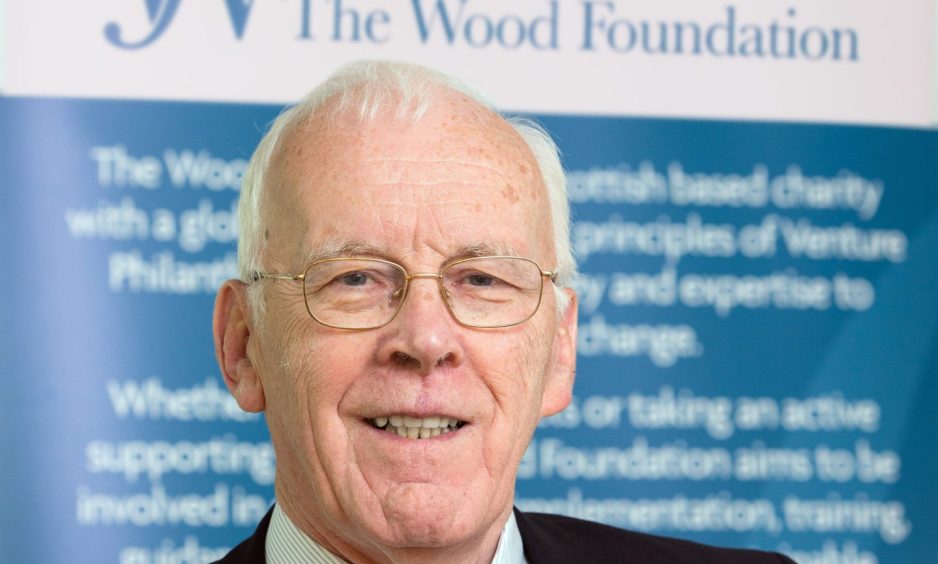Seven years ago, Aberdeen engineering firm Wood was valued at more than £5 billion and it bought one of its biggest rivals as part of growth plans.
Now the group is worth less than £200 million. So, where has it all gone wrong?
Wood, also known as John Wood Group Plc, is an engineering and consulting company which specialises in energy, infrastructure, and industrial sectors.
The business was founded in 1982 by Sir Ian Wood after splitting away from fishing company JW Holdings.
Sir Ian was chief executive until 2006 and chairman until 2012. From its creation until the end of the 2000s, the Wood family held as much as 40% of all available shares.
It employs more than 35,000 people in more than 60 countries.
But since 2017, failed takeover attempts, job cuts and plunging profits have led to its share prices dropping by more than 97%.
Did Wood engineer its own downfall with £2.2bn purchase?
In October 2017, Wood completed a takeover of project management firm Amec Foster Wheeler.
The deal was worth £2.2bn and the then-Wood chief executive, Robin Watson, said the strategy made “as much sense as it ever has”.
It was also expected to accelerate its growth strategy by four years, as well as providing jobs potential for the north-east.
Mr Watson said the deal sent a clear message that there is “life outside London”.
Following the deal, on October 31 2017 the company’s value rose £4.82bn.
However, the deal caused significant challenges for Wood. The acquired company brought substantial debt and legal liabilities with it.
In 2016, Amec Foster Wheeler was sued by Enterprise Products Limited over a contract for a chemicals plant in Texas.
The US midstream energy services company was initially seeking more than £550m amid cost increases and delays to reimbursable payments.
However, Wood agreed a settlement of around £97.5m, which was paid over seven days in 2022.
The Amec Foster Wheeler deal also ended up in a £140m settlement in 2021, relating to historical bribery and corruption charges.
The legal repercussions came after Amec Foster Wheeler conspired to pay approximately £870,000 in bribes to officials at Brazil’s state-owned Petrobas.
From record-high to share price crisis for Wood
In September 2018, Wood’s value was at an all time high of £5.23bn.
In June, the engineering firm had announced funds to explore new technology to aid nuclear decommissioning.
Then, in its annual report for 2018, it showed an improved loss of £6m, compared to an almost £24m deficit the year before. Its revenue had also almost doubled to £7.95bn.
However, a year later its market cap had halved to £2.6bn. So, what happened?
In Wood’s 2019 accounts, the group reported a profit of £57.5m and only a slight fall in revenue to £7.85bn.
Its debts showed a different story. The figure totalled £2.98bn, up by more than £650m.
The company had also taken a loss on its sale of its subsidiary Terra Nova Technologies.
The £29.1m sale was part of a “strategic review” from Wood to divest parts of its portfolio.
It reported expenses of £33m in restructuring and redundancy costs. Investigation support costs were also reported, setting the group back £44.8m in 2019.
Wood wasn’t immune to Covid
Like most firms, Wood Group was hit hard by Covid, and it said it had been forced to cut jobs as well as furloughing workers.
Although it didn’t confirm how many people were laid off, Wood also revealed it had asked other employees to take a temporary 10% cut in base salary.
The company estimated it would generate savings of around £32m from this process.
In another response to Covid, the group cancelled its 2019 final dividend and postponed its annual general meeting from May 7.
Its market cap continued to fall, and it ended 2020 worth £2.14bn.
Chief executive stands down
In April 2022, Mr Watson announced his intentions to step down from his chief executive role and retire.
The company announced the decision alongside its 2021 full year results, which showed that its revenues were down 14% on 2020.
Ken Gilmartin would become chief executive in July 2022, moving up from chief operating officer.
At the time, he said: “It really does feel like I’m coming home.”
After Mr Watson’s announcement, the firm saw its market value rise to £1.55bn.
Once Mr Gilmartin was appointed, the stock market cap dropped to £990m – the first time under £1bn since November 2014.
Takeover offers knocked back
Following the series of setbacks, Wood had become a takeover target for other oil and gas companies.
At the beginning of 2023, Wood knocked back three proposals US firm Apollo Global Management – starting at 230p per share before rising to 235p and then 240p.
In March after a market shift, Wood knocked back a fourth takeover offer from Apollo of 237p per share, roughly valuing Wood at £1.64bn.
Why did the engineering group turn it down? It said the offer “continues to undervalue” the firm.
Less than a month later, Apollo moved to try and break the deadlock with a final proposal of 240p per share.
Wood announced it would work with the US firm to try and make a deal happen.
It never materialised, and share prices fell by 34% on May 15 to 145p when Apollo pulled the plug.
An annus horribilis
Wood started another year of crisis by revealing plans to cut 22 jobs in Aberdeen,
Speculation had also been mounting that Wood was going to be exiting the city.
But this has been denied with a spokesman for the energy services giant confirming it is going nowhere.
In August, another £450m was wiped from its value after another buyer walked away from a takeover deal.
After offering £1.6bn in June, Dubai-based engineer Sidara, confirmed to Wood it won’t be pursuing the acquisition.
It said the decision was made “in light of rising geopolitical risks and financial market uncertainty”.
Wood share prices dropped 38% from the closing price on August 2 of £1.97 to £1.21 on the morning of August 5.
A couple of weeks later, the group revealed a £756m half year loss, with revenues of £2.1bn down 5% in the six months to June 30.
The loss included a £626m impairment charge and a £107m loss to exit contracts as it shifted its strategy.
August did bring some good news for the firm, as it announced it was selling two businesses in deals worth £125m.
The group signed an agreement for the sale of its majority stake in Aberdeen-based Ethos Energy, as well as its equity in CEC Controls.
In November, it saw yet another dramatic collapse in its share price – this time by more than 60%.
The engineering firm saw the freefall when it announced an “urgent” independent review of its books.
Wood’s value fell by £500 million as its shares dropped from Wednesday’s closing price of £1.24 to as low as 49.8p a share.
And now…
Could 2025 be the year in which Wood turns its luck around? The answer is no, not yet anyways.
The engineering firm revealed a “difficult” and “disappointing” financial year and said “significant work” has taken place since the start of its “urgent” independent review by Deloitte, which is still ongoing.
Deloitte identified “weaknesses and failures” in Wood’s financial culture, governance and controls.
The firm expected a “very strong” trading performance in the final quarter of 2024 but it failed to materialise.
This lead to the decision to cancel its annual executive and employee bonus for the year.
It also revealed it expects a negative cash flow of £120m to £160m in 2025.
And finally, on February 19, Wood’s chief financial officer resigned after 11 months over an “incorrect description of his professional qualifications”.
The board accepted Arvind Balan’s decision with immediate effect after he made an “honest oversight” describing himself as a chartered accountant instead of a certified practicing accountant.
On February 13, its closing price was 65.4p. One week on, it sits under 26p.
Is there any way back for Wood?
Despite all of the troubles and share price plummets, Wood says it is undergoing a “transformation”.
Chief executive Mr Gilmartin confirmed further actions to address the cost base of the business to the right size are under way.
He believes there is a “very clear route” to a positive cash flow in 2026.
Wood can be confident the fundamentals of its company remain strong after increasing its order book to around £5 billion.
It will hope the findings of the Deloitte review will help it find its way back to being one the world’s most valued energy and engineering firms.







Conversation